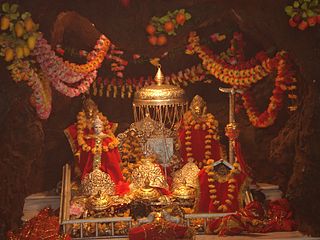
Vaishno Devi is a manifestation of the Hindu mother goddess Durga or Adi Shakti. Vaishno Devi is worshipped as a combined avatar of the goddesses Mahakali, Mahalakshmi, and Mahasaraswati. And She is the Kaliyugi Avatar of Kalika. Additionally, she is seen as the potency of Hari or Vishnu.
Vindhyachal is a city in Mirzapur district of the Indian state of Uttar Pradesh. The city is a Hindu pilgrimage site having the temple of Vindhyavasini, who according to Markandeya Purana had incarnated to kill the demon Mahishasura. A detailed description has been given in the 'Durga Saptashati' Chapter of Markandeya Purana. The river Ganga flows through this city. The Indian Standard Time (IST) line passes through the Vindhyachal railway station.

The Shakti Pithas or the Shakti Peethas are significant shrines and pilgrimage destinations in Shaktism, the goddess-centric denomination in Hinduism. The shrines are dedicated to various forms of Adi Shakti. Various Puranas such as Srimad Devi Bhagavatam state the existence of varying number of 51, 52, 64 and 108 Shakti Pithas of which 18 are named as Astadasha Maha (major) in medieval Hindu texts.
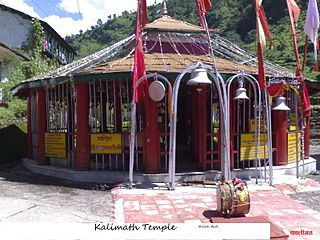
Kalimath is a village in Rudraprayag District of the Indian state of Uttarakhand. It is regarded as a divine place and shakti peeth.

Hanuman Temple in Connaught Place, New Delhi, India, is an ancient Hindu temple and is claimed to be one of the five temples of Mahabharata days in Delhi. The other four temples are the Kalkaji, a Kali temple in South Delhi containing Swayambu rock Idol, the Yogmaya Temple near Qutub Minar, the Bhairav temple near the Purana Qila and the Nili Chatri Mahadev at Nigambodh Ghat outside the walls of Old Delhi.

Bhadrakali, is a Hindu goddess She is considered to be the auspicious and fortunate form of Adi Shakti who protects the good, known as bhadra.

Santoshi Mata or Santoshi Maa is a Hindu goddess, who is venerated as "the Mother of Satisfaction", the meaning of her name. Santoshi Mata is particularly worshipped by women of North India and Nepal. A vrata called the Santoshi Maa vrata performed by women on 16 consecutive Fridays wins the goddess' favour.
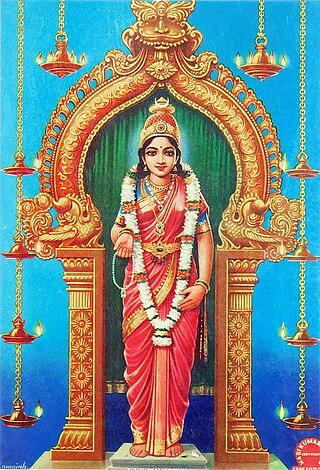
Devi Kanya Kumari is a manifestation of the Hindu goddess Mahadevi in the form of an adolescent girl. She is variously described by various traditions of Hinduism to either be a form of Parvati or Lakshmi. She is also worshipped as an incarnation of the goddess Bhadrakali by Shaktas, and is known by several names such as Shrī Bāla Bhadra, Shrī Bāla, Kanya Devi, and Devi Kumari.

In Hinduism, the yatra (pilgrimage) to the tirthas has special significance for earning the punya needed to attain the moksha (salvation) by performing the darśana, the parikrama (circumambulation), the yajna, the Dhyana, the puja (worship), the prarthana, the dakshina, the seva, the bhandara, etc. These sacred places are usually located on the banks of sacred waters, such as sacred rivers or their tributaries, the kundas, the ghats, or the stepwells, or the temple tanks.

The Maa Sarala Temple is a Hindu temple in the district of Jagatsinghpur, Odisha, India. It is one of the eight most famous Shakta shrines of Odisha.
Mahamaya Kalika Saunsthan is a temple complex in Kansarpal village of Bicholim taluka in the state of Goa, India. The presiding deity of the temple is Kali worshipped in the form of Mahamaya. The goddess Kali, the terrible and cruel to the demons and evil doers, is worshiped with blood sacrifice in most parts of India, in Goa however the fierce invocation of the deity was never popular. As per the tradition, after slaying the demons Madhu and Kaitabha, the deity's anger was soothed and the deity manifested herself in a peaceful (Shanta), gentle (Soumya) form, which is very popular in Goa.This form of Kali is also known as Bhadrakali or Kali who is gracious.

Tara Tarini Temple is a famous Hindu shrine of Adi Shakti on Kumari hills at the bank of Rushikulya river near Purushottampur in Ganjam district of Odisha. It is situated around 28km from Brahmapur city. Maa Tara Tarini is worshipped as the Breast Shrine of Adi Shakti Sati Devi here. The temple is one of the oldest pilgrimage centers of Mother goddesses and one of the four major Shakti Peethas and Tantra Peethas of India.
Shivaharkaray or Karavipur is a Shakti Peeth dedicated to the Hindu Goddess Durga, located near Parkai railway station, near Karachi, Pakistan. It is one of the three Shakti Peethas in Pakistan, other two being Hinglaj Mata mandir and Sharada Peeth. The Puranas describe that the three eyes of the Goddess fell here after she committed Sati. The Goddess is worshipped as Mahishasuramardini, or the slayer of the Demon Mahishasur. Her consort, the Hindu God Shiva, is worshipped in Ragi form as Krodhish, personification of anger. Shivaharkaray is third in the list of 51 Peethas identified in the Puranas.

Kalaratri is the seventh of the nine Navadurga forms of the goddess Mahadevi. She is first referenced in the Devi Mahatmya. Kalaratri is one of the fearsome forms of the goddess.
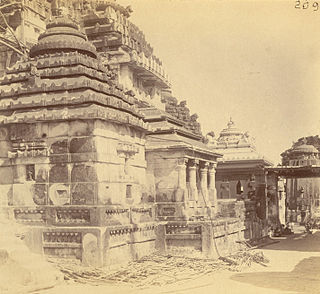
The Vimala Temple or Bimala Temple is a Hindu temple dedicated to goddess Vimala or Bimala (ବିମଳା), located within the Jagannath Temple complex in Puri in the Indian state of Odisha. It is generally regarded as a Shakti Pitha, among the holiest temples dedicated to the Hindu Goddess.
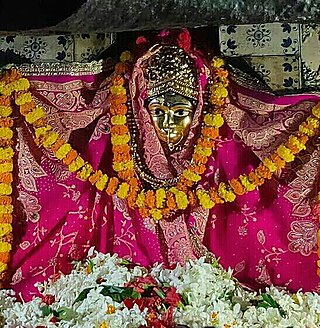
Maa Tara Chandi Temple is a Hindu temple dedicated to Maa Shakti or Maa Durga, located in Sasaram, Bihar, India. It is one of the 51 Shakti Peetha.

The Mahakal Temple or Mahakal Mandir is a sacred Hindu temple located in Darjeeling in the state of West Bengal, India dedicated to the Hindu god Shiva, the third god in the Hindu triumvirate. The Temple was built in 1782 by Lama Dorjey Rinzing and is perched atop the Observatory Hill in Darjeeling and is an amalgamation of Hindu and Buddhist religions. It is a unique religious site where both religions coexist harmoniously.


















